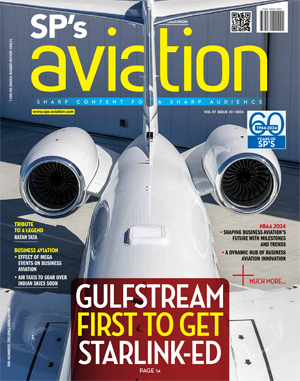INDIAN ARMED FORCES CHIEFS ON OUR RELENTLESS AND FOCUSED PUBLISHING EFFORTS

SP Guide Publications puts forth a well compiled articulation of issues, pursuits and accomplishments of the Indian Army, over the years

"Over the past 60 years, the growth of SP Guide Publications has mirrored the rising stature of Indian Navy. Its well-researched and informative magazines on Defence and Aerospace sector have served to shape an educated opinion of our military personnel, policy makers and the public alike. I wish SP's Publication team continued success, fair winds and following seas in all future endeavour!"

Since, its inception in 1964, SP Guide Publications has consistently demonstrated commitment to high-quality journalism in the aerospace and defence sectors, earning a well-deserved reputation as Asia's largest media house in this domain. I wish SP Guide Publications continued success in its pursuit of excellence.
Defending the Airspace

The key to comprehensive air defence capability lies in the ability to provide seamless, multi-layered, round-the-clock, radar cover for the entire airspace of the national territory and adjoining areas
Who in this country and specially in the Indian Air Force (IAF) could forget the fateful evening of December 17, 1995, when a Russian-built An-26, on a flight from Karachi in Pakistan to Dhaka in Bangladesh and laden with a cargo of illegal arms and ammunition dropped the entire lethal load clandestinely in Purulia, a remote district of West Bengal, by hoodwinking the radar/air-traffic controllers at Kolkata. Was it not for an alert IAF corporal at the Chennai (FIC) which started a chain-reaction ordering the aircraft to return to Mumbai, the audacious crew and the unscrupulous arms dealer on board would have managed to escape from the Indian airspace on their return journey from Bangkok to Karachi? Paradropping of such a large cache of weapons and ammunition over Indian territory by a foreign aircraft with total impunity represented severe public embarrassment for New Delhi. However, the timely (even though somewhat imaginary) threat of being shot down, forced the aircraft to land at Mumbai. While its subsequent apprehension by the concerned authorities did save the blushes for the Indian government, it also brought to light gaping holes in India’s radar surveillance capabilities.
Air Defence: IAF Responsibility
India’s Union War Book pins the responsibility of defending the country’s skies squarely on the shoulders of the IAF. The IAF on its part has tried to discharge this responsibility to the best of its ability but the key to comprehensive air defence capability lies in the ability to provide seamless, multi-layered, round-the-clock radar cover for the entire airspace of the national territory and adjoining areas. The IAF has painstakingly built up its radar surveillance capability by acquiring a sizeable number of different types of radars. But because of paucity of resources, its air surveillance capability has been basically configured around perceived external threats only and its radars deployed accordingly. It has tried to put a judicious mix of radars such as high power/high altitude (HPR), medium power/medium altitude (MPR) and low level transportable (LLTR) to cover the multi-layered airspace, but looking at the size of the Indian territory, it is obvious that it cannot possibly cover the entire spectrum of the whole airspace.
It is presumed that the IAF has good coverage of the airspace in the areas of its western border and adequate coverage in the east, but the same may not be true of its mountainous northern and north-eastern borders. Similarly, it would have limited capability in the central zone and the southern peninsula. The IAF’s oldest US built Star Sapphire HPRs were replaced by the French THD-1955 radars which themselves are becoming obsolescent and need replacement. Similarly, its French designed MPRs PSM-33 and TRS-2215, licence-produced by Bharat Electronics Ltd, have aged considerably. The LLTRs of the IAF have been generally of Russian origin such as Pechora-linked P-18/P-19 and, ST-68 radars. However, inadequacy in numbers restricts their deployment to cover only the specific areas of interest.
Looking at its entirety, the Indian airspace covers an area of approximately 3,290,000 sq km over its land mass alone. If one has to take into account additional requirements to cater for the desirable early warning capability then the airspace would almost double to 7,000,000 sq km. In the modern concept of airspace management, it would be necessary to provide 100 per cent radar coverage over the entire area of interest with adequate overlap and built-in redundancy. It is evident that for this kind of coverage all national resources would have to be pooled and networked to provide the desired capability for radar surveillance of the country’s entire airspace, which means that apart from its own radar resources, the IAF would have to draw heavily on the radar capabilities of not only its sister services i.e. Indian Army and the Navy, but also the civil radars of the Airports Authority of India (AAI), etc. How will this be achieved to cater to the multi-level surveillance requirements for full-spectrum coverage?
High/Medium Power (High/Medium Altitude) Radars
The civil aviation area and route surveillance radars are essentially meant for high/medium level coverage where the civil air traffic normally operates. However, till recently, against an optimum requirement of 60, there were only 12 such radars in the country—basically to cater to the needs of the country’s metro airports. The AAI is gradually adding more radars as part of its modernisation plans for the nonmetro sectors as well with the new figure reportedly being in excess of 20 now. When fully integrated with the IAF’s high and medium power radars, these would greatly help in creating better area coverage at high/medium levels for the IAF’s air defence network. IAF’s bid to get 30 Rohini 3-dimensional central acquisition radar from BEL in a phased manner would further help fill the gaps in radar surveillance at medium levels.





